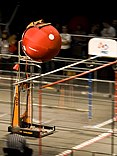
The Ames Research Center (ARC), also known as NASA Ames, is a major NASA research center at Moffett Federal Airfield in California's Silicon Valley. It was founded in 1939 as the second National Advisory Committee for Aeronautics (NACA) laboratory. That agency was dissolved and its assets and personnel transferred to the newly created National Aeronautics and Space Administration (NASA) on October 1, 1958. NASA Ames is named in honor of Joseph Sweetman Ames, a physicist and one of the founding members of NACA. At last estimate NASA Ames had over US$3 billion in capital equipment, 2,300 research personnel and a US$860 million annual budget.

Stack Attack was the game for the 2003 FIRST Robotics Competition. Two teams of two robots compete by moving large Sterilite bins into their zones and arranging them into stacks.
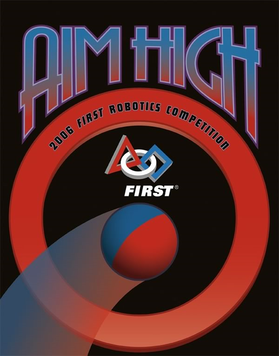
Aim High was the 2006 game for the FIRST Robotics Competition. The competition involved teams competing to gain points by delivering balls into goals and positioning their robots in certain positions on the playing field. The teams took it in turn to provide defense and attack.

Triple Play was the name of the 2005 season FIRST Robotics Competition game.
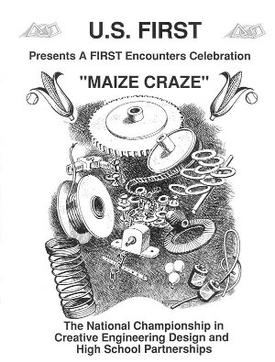
Maize Craze was the game in the inaugural year, 1992, of the FIRST Robotics Competition. This game was played by four individual robots trying to collect tennis balls into their starting base. An impediment to the robots was that the entire playing field was covered in a layer of corn 1-2 inches thick.

Rug Rage was the 1993 game of the FIRST Robotics Competition. In it, teams competed individually to score as many balls as possible in their goal.

Zone Zeal was the 2002 game for the FIRST Robotics Competition. In it, robots playing in alliances of two competed to move goals and balls into various zones within the playing field.

Tower Power was the 1994 game for the FIRST Robotics Competition.
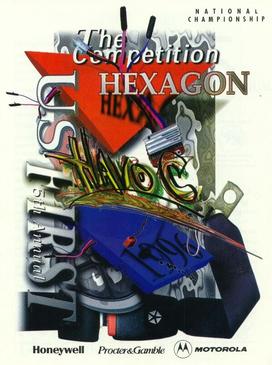
Hexagon Havoc was the 1996 game for the FIRST Robotics Competition. Seeding games of 1-on-1-on-1 were played double-elimination to determine the teams for the finals rounds. In the finals, robots played 1-on-1 in a best 2 out of 3.

Toroid Terror was the 1997 game for the FIRST Robotics Competition. This was the first year that FRC had a regional event outside its origins in New Hampshire; in addition to Manchester, regionals were held in Chicago and New Brunswick, New Jersey, as well as the championship event at a complex set up in the Epcot parking lot. It was also the first year in which the scoring object was not a ball.

Ladder Logic was the game for the 1998 FIRST Robotics Competition.
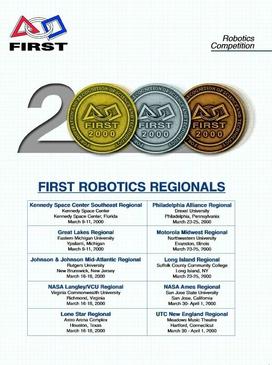
Co-Opertition FIRST was the 2000 game for the FIRST Robotics Competition.
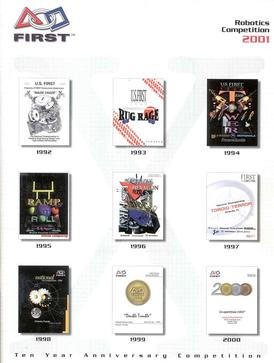
Diabolical Dynamics was the 2001 game for the FIRST Robotics Competition.

Rack 'n Roll was the game for the 2007 FIRST Robotics Competition season, announced on January 6, 2007. In it, two alliances of three teams each competed to arrange ring-shaped game pieces on a central arena element known as 'The Rack'.

Botball is an educational robotics program that focuses on engaging middle and high school aged students in team-oriented robotics competitions. Thousands of children and young adults participate in the Botball program. It has been active since 1998 and features a robotics curriculum which focuses on designing, building and programming a pair of autonomous robots. Teams use a standardized kit of materials, document the process and then compete in a tournament in which the challenges change annually. All materials in the kits are exactly the same for every team around the world, so there are no unfair advantages. Botball teams are mostly based in the United States with over 300 teams and local tournaments in more than a dozen regions. In recent years it also holds an annual Global Conference on Educational Robotics (GCER), with an international tournament that attracts teams all over the country as well as from Mexico, Austria, China, Uganda, Poland, Qatar, Kuwait, Egypt, and many others.

The FIRST Championship is a four-day robotics championship held annually in April at which FIRST student robotics teams compete. For several years, the event was held at the Georgia Dome in Atlanta, Georgia, but moved to the Edward Jones Dome in St. Louis, Missouri in 2011, where it remained through 2017. In 2017, the Championship was split into two events, being additionally held at the George R. Brown Convention Center and Minute Maid Park in Houston, Texas. In 2018 and 2019, the Championship was held in Houston and Detroit, Michigan at the TCF Center and Ford Field. The event comprises four competitions; the FIRST Robotics Competition Championship, the FIRST Tech Challenge World Championship, the FIRST Lego League World Festival, and the FIRST Lego League Junior World Expo.
Breakaway is the game for the 2010 FIRST Robotics Competition, announced on January 9, 2010. Robots direct soccer balls into goals, traverse "bumps" in the field, suspend themselves and each other on towers, and/or go through a tunnel located in the center of the field.

Logo Motion is the 2011 FIRST Robotics Competition game. Playing pieces are inner tubes shaped like the components of the FIRST logo. The primary objective of the game is to place them on racks to gain points. In the endgame, robots deploy smaller robots ("minibots") to climb a tower. Minibots must be made from the FIRST Tech Challenge kit of parts. The game celebrates the 20th season of the FRC and is also meant to commemorate the artist Jack Kamen, who designed the original FIRST logo.

Ultimate Ascent was the 2013 FIRST Robotics Competition game. It is styled similarly to disc golf.

Destination: Deep Space, stylized as DESTINATION: DEEP SPACE and officially known as Destination: Deep Space Presented By The Boeing Company, is the FIRST Robotics Competition game for the 2019 season. It involves two alliances of three teams each, with each team controlling a robot and performing specific tasks on a field to score points. The game centers around an outer space theme involving two alliances consisting of three teams each competing to place poly-carbonate hatch panels and orange rubber balls or "cargo" on rockets and cargo ships before returning to their HAB platform to climb at the end of the match.





















